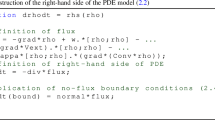Abstract
The stochastic interpolation (SI) framework of function recovery from input data comprises a de-convolution step followed by a convolution step with row stochastic matrices generated by a mollifier, such as a probability density function. The choice of a mollifier and of how it gets weighted, offers unprecedented flexibility to vary both the interpolation character and the extent of influence of neighbouring data values. In this respect, a soft computing method such as a genetic algorithm or heuristic method may assist applications that model complex or unknown relationships between data by tuning the parameters, functional and component choices inherent in SI. Alternatively or additionally, the input data itself can be reverse engineered to recover a function that satisfies properties, as illustrated in this paper with a genetic programming scheme that enables SI to recover the analytical solution to a two-point boundary value convection–diffusion differential equation. If further developed, this nascent solution method could serve as an alternative to the weighted residual methods, as these are known to have inherent mathematical difficulties.





Similar content being viewed by others
Notes
Boole’s rule was mistakenly known as Bode’s rule, see p. 886 of Abramowitz and Stegun (1972).
References
Abramowitz M, Stegun IA (1972) Handbook of mathematical functions with formulas, graphs, and mathematical tables, 9th printing. New York, Dover
Axelsson O, Barker V (1984) Finite element solution of boundary value problems. Academic Press, London
Benson DJA (1991) Finite volume solution of Stokes and Navier–Stokes equations. Ph.D. thesis. University of Oxford, UK
Boole G, Moulton JFA (1960) Treatise on the calculus of finite differences, 2nd edn. Dover, New York
Gresho PM, Lee RL (1979) Don’t suppress the wiggles—they’re telling you something. In: Finite element methods for convection dominated flows. Proceedings of the winter annual meeting, New York (A80-27887 10-34). American Society of Mechanical Engineers, New York, pp 37–61, 2–7 Dec 1979
Hemker PW (1977) A numerical study of stiff two point boundary value problems. Ph.D. thesis. In: MCT 80.Mathematical Centre, Amsterdam
Howard D, Roberts SC (2001) Genetic programming solution of the convection–diffusion equation. In: Lee Spector et al (ed) Proceedings of the genetic and evolutionary computation conference (GECCO-2001). Morgan Kaufmann, San Francisco, pp 34–41, 7–11 July 2001
Howard D, Kolibal J, Brezulianu A (2009) Engineering presentation of the stochastic interpolation framework and its applications. Soft Comput (accepted)
Koza JR (1992) Genetic programming: on the programming of computers by means of natural selection. MIT Press, Cambridge
Morton KW (1996) Numerical solution of convection–diffusion problems. Applied mathematics and mathematical computation, vol 12. Chapman and Hall, London
Author information
Authors and Affiliations
Corresponding author
Rights and permissions
About this article
Cite this article
Howard, D., Brezulianu, A. & Kolibal, J. Genetic programming of the stochastic interpolation framework: convection–diffusion equation. Soft Comput 15, 71–78 (2011). https://doi.org/10.1007/s00500-009-0520-3
Published:
Issue Date:
DOI: https://doi.org/10.1007/s00500-009-0520-3




